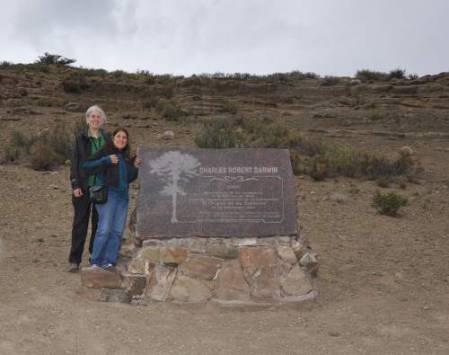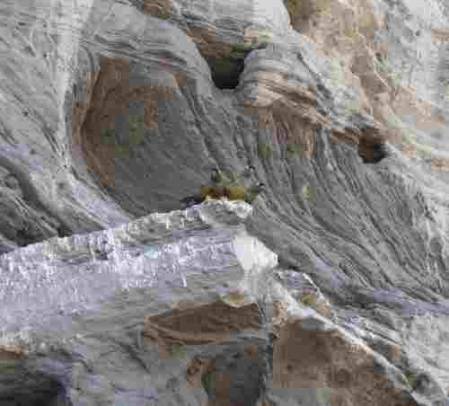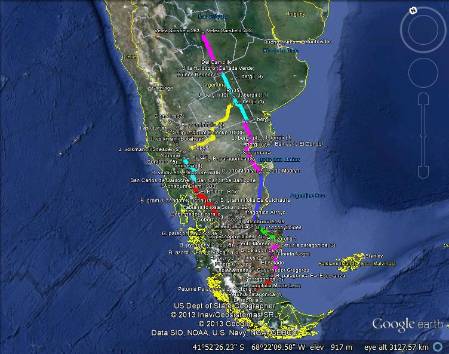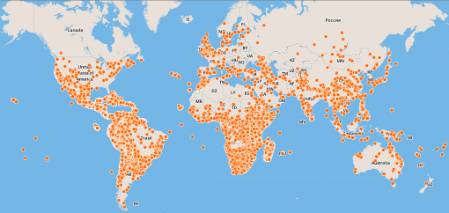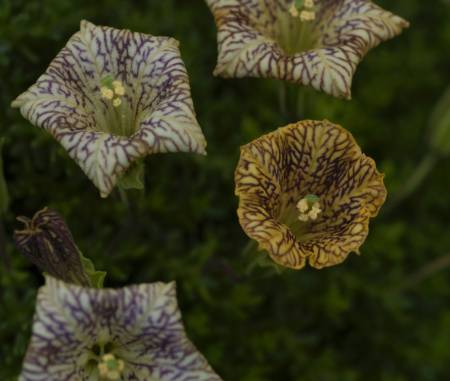After a day of working the in herbarium in IADIZA ( Instituto Argentino de Investigaciones de las Zonas Aridas), where Iris works, we set off again to look for wild tobaccos, cacti and purslanes in the valleys leading to the high mountains in the more southern part of the province of Mendoza.
We made an early start, as we had far to go and little time! Iris and I were accompanied by Pablo Molina, her student who will be studying the phylogeny of cacti and purslanes, and Gualberto Salazar, who was driving, but was a dab hand at botany as well. Driving south from Mendoza to join my old friend Ruta 40 again we saw to the west the Cordillera, here called the “Chain of Silver” for the high snowy peaks that are always snow-covered.
Cordon de Plata in the morning light – the highest peak to the left is Tupungato, almost as tall as Aconcagua, but difficult to access and climb, thus less well-known
Accessing the mountains involves driving out to flatter land in the east, then west again into deep valleys where rivers have carved out the mountains and roads can enter. We were heading for the Laguna Sosneado – we thought it might be an old name for the lake now called Laguna Blanca near the town of Sosneado, but no, we were wrong!
We stopped in the town to ask and were told exactly how to get there…. forty kilometres in on a dirt road up the Río Atuel, which was bad and then got worse. The valley was broad and rocky and the river must have been pretty impressive in full flood – as it was it was running quite red from rain in the upper reaches. The road was perfectly all right – not bad at all!
The flat valley bottom of the Río Atuel is composed of sandy gravel – the plants trap the sand as it blows in the wind and small hillocks called “monticolos” are formed
We decided to drive straight to the lake, rather than stopping on the way up, as our locality data from the herbarium had cited the lake as a collecting site for several species we were looking for, among them a strange Jaborosa that Gloria and Franco from Córdoba were seeking.
The lake was a jewel in the dry vegetation all round – it was fed by small springs and was surrounded by grass. A gaucho 'puesto' or summer station was located at the lake – sheep, goats and horses are brought up the valley to graze in the summer, and then taken down again once the snow begins to fall in the autumn. What a place to spend the summer!
Laguna Sosneado – surrounded by rich grass that grows in what are called in Argentina 'vegas' – patches of lush vegetation near the water from springs in the middle of otherwise very dry scrub. The lake was beneath some tall basalt cliffs, evidence of the volcanic past of the region
Above us in the mountains we heard thunder and the sky turned black; rain fell, but not much – the show was spectacular though! We looked and looked around the lake and in the hills surrounding it for the Jaborosa and for the tobaccos also cited for the area, but to no avail. As it was really beginning to rain and it was getting late (again – it seems to be the story of this field trip!) we decided to go back down the valley…
The storm came from the west over the Andes – storms in central Argentina can be very violent and hail often falls, damaging the famous vineyards further to the east. Nearer Mendoza they seed the clouds to prevent hail during these storms.
We did, however, see some pretty amazing cacti – this individual plant of the cactus Maihuenopsis was about 2 metres in diameter – from the car the mounds these cacti formed looked like sheep! This particular species was very common at one particular section of the valley – starting at about 1800 metres elevation and higher.
Pablo was excited to find such large individuals – they were in fruit as well, so he could collect seeds to study their anatomy and structure
As we drove down the valley we looked for plants as we descended – as we had driven straight up to the lake, we were looking harder on the way down! Iris spotted what she thought was a wild tobacco – so we stopped. And my goodness, we found just the species we were looking for – Nicotiana linearis and Nicotiana spegazzinii. As part of long-term studies I have been doing with colleagues from Kew and Queen Mary, Laura Kelly has discovered that these two species are possibly of hybrid origin and is interested in studying them further. Once we stopped and began to walk around the ground was covered with Nicotiana linearis – it is a tiny little plant only a few centimetres tall, so not easy to see from the truck driving along.
The flowers of Nicotiana linearis are held in tight clusters, each flower is less than a centimetre long and is a dirty white colour. The whole plant is covered with sticky hairs – in this place, all covered with sand!
Nicotiana spegazzinii was much less common that Nicotiana linearis – we only found a few plants, but what was really exciting was that we found intermediates – the two are not as distinct as it appears from the descriptions in the published literature! This will be a perfect place to return to study these plants in more detail – in the daytime! As usual, the best discoveries are made at the end of the day, when the light is dimming and night is falling….
Nicotiana spegazzinii has larger flowers (still only about a centimetre long) that are widely spaced along the stems and although it is sticky, does not have such long hairs as does Nicotiana linearis
It really started to rain as we finished up collecting the wild tobaccos – and we headed further south to Las Leñas, where we had reserved a room in a ski resort for the night. The central Andes in Argentina are a big skiing destination – the snow is deep and the scenery spectacular – but these resorts are not much used in the summer, so rooms are cheap! As usual, we arrived at about 10 pm – not late for eating by Argentine standards…. We still had a lot of plant organising to do though, and the next day to plan, back into the Andes up the valley.



